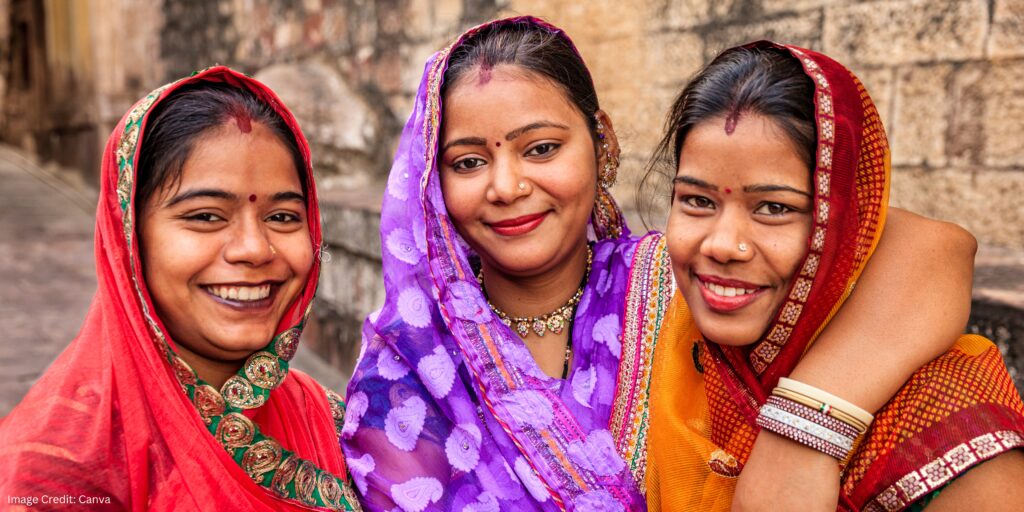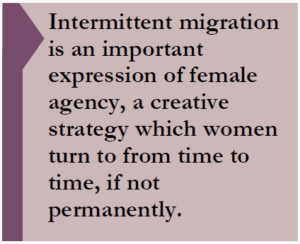
 With good reason, the scholarship on female migration in India has largely been about marriage migration as it is the largest permanent migration stream in the world. The near universality of marriage, and its features of patrilocality, and village exogamy (especially in the populous states of North India), make it so. The emphasis on marriage as an end and the presumed stability of female migration after marriage is consolidated by the periodic National Sample Surveys (NSS) in their choice of data categories. The NSS classifies females as ‘single migrants’ (also called solo migrants), ‘marriage migrants’ (who move on marriage) and ‘followers’ (of husbands some years after they have moved to the city). We cannot grasp the dynamics of female migration within and beyond marriage from this data.
With good reason, the scholarship on female migration in India has largely been about marriage migration as it is the largest permanent migration stream in the world. The near universality of marriage, and its features of patrilocality, and village exogamy (especially in the populous states of North India), make it so. The emphasis on marriage as an end and the presumed stability of female migration after marriage is consolidated by the periodic National Sample Surveys (NSS) in their choice of data categories. The NSS classifies females as ‘single migrants’ (also called solo migrants), ‘marriage migrants’ (who move on marriage) and ‘followers’ (of husbands some years after they have moved to the city). We cannot grasp the dynamics of female migration within and beyond marriage from this data.
I draw on research with migrants to two cities, Delhi and Hyderabad, to understand how rural migrants to the informal economy make urban India. How do they remain entangled with their villages? How do they make and re-make the city and the village and themselves in the process? My collaborator, Vinay Gidwani (University of Minnesota) and I aim to tell humanistic stories, to acknowledge the poetics of ordinary lives.
Oral history interviews are our primary research methodology. We interviewed a hundred and thirty-five people in Delhi and Hyderabad bastis (slums) and accompanied ten back to their villages. The women were domestic service workers, janitors, street vendors, dhobis, beauty service providers, and garment workers. Women who were not doing paid work but mainstays of their household economies as basti property owners, who rented out their properties, and small-time contractors were also interviewed. Fourteen such stories are shared in our book, Betweens: City Lives, Rural Ties (under review). Although each story is singular, each life is also paradigmatic, revealing the larger forces at play in contemporary India.
Our interviews with women revealed that migration is not a one-off event. Over the course of their lives, they shape and re-shape the timing and direction of their own migration in surprising ways.
Women left-behind in villages by migrant husbands initiate migration to the city to escape the interminable drudge of domestic work -cooking, cleaning, sweeping-swabbing, caring for the elderly and children and those who are disabled or sick -for the entire extended marital household, often of eight to ten people. Putli and Usha, impoverished, Rajput women from Uttar Pradesh, were restricted from moving outside their marital households, overburdened with domestic labor and emotionally and physically ill- treated by their in-laws. Impossibly, for young daughters- in-law who, in keeping with Rajput caste-patriarchy (“ladki jaat hai”), wore their ghunghats (veil) low and literally did not know their way around their marital villages; they imagined, plotted, and acted, to escape.
However, the break is never complete. Nearly everyone continues to be embedded in trans-local households, intergenerational and spatially split between the city and village (Ramamurthy, 2020). Inevitably, even the women who escape the hellhole of their village marital households, return to the marital village from time to time (Ramamurthy and Gidwani, 2021). But many now do so on their own terms. As moral selves, they come to value the transformations enabled by migration as moral transformations. Getting paid work in the city or earning an income by selling beauty services, street food, or parlaying property into rental income are some of the ways women developed this ability.
Nor is the direction of intermittent migration only away from their marital villages to the city. Women, like Putli, run away from their husband’s domestic violence in their conjugal city households to go back to their natal villages for care. The structural violence of the lack of access to affordable health care in the city is another reason why women return for medical treatment and recuperative care to their village maikes (mothers’ homes). This, too, is temporary, treated as a reprieve, but often is a recurring one.
Intermittent migration within marriage is not the only phenomenon we observed. Beyond the boundaries of marriage, a few married women shared stories of how they have spent time with a man other than their husbands. Once, her husband’s relentless drunken beatings led Putli to run away with a male friend to a strange city. He was kind and wanted to marry her. He, too, was Rajput, her caste, but she chose not to as she was not attracted to him. She anticipated that, in time, he would make her send her son back to his father. Improbably, Putli returned to her husband after a few years, as she still found him “beautiful”. But on her own terms. His taunts that she is a dirty woman don’t stick. She earns an income from her work as a janitor. She knows from her city neighbors that there are anti-domestic violence laws. The respectability she gets as a married woman in the city and her natal and marital villages is incontestable, she reasons.
Young, unmarried women, in their twenties and early thirties, shared their stories of intermittent migration with a romantic friend or lover. Meena, from an Adivasi village in Jharkhand, has been migrating for child and elder care work since she was a child of eight. She’s been to Ranchi, Chandigarh, Delhi, Mumbai, and Hyderabad to work. Though free time is scarce for live-in domestic service workers, Meena used to take her charge down to a park to play every day, where she met and fell in love with Mahesh, relatively “upper caste” and Telugu, who worked as a driver. Their love story, on Meena’s admission, sounds straight out of a Bollywood film.
It’s one of intermittent migration to Bengaluru to escape her middle-class employer’s and Mahesh’s parents’ wrath; to her natal village, to abort her out-of-wedlock pregnancy; and back to Hyderabad to work and save for their wedding. Ujjwala, a garment worker, Dalit, from a village in Uttar Pradesh, has a boyfriend in Delhi, with whom she has gone to see the Taj Mahal and other romantic spots. She returns to her native village from time to time. She finds the gender norms extremely constricting in the village but goes back as she is educating herself and takes her exams there, first for a B.A and now an M.A degree.
 Why pay attention? Because intermittent migration is an important expression of female agency, a creative strategy which women turn to from time to time, if not permanently.
Why pay attention? Because intermittent migration is an important expression of female agency, a creative strategy which women turn to from time to time, if not permanently.
It may seem a small intervention but, in the context of their lives, it is nothing short of remarkable.
Intermittent migration demands new kinds of data, capable of capturing the dynamism of female movements between natal and marital villages and cities. To address the underlying reasons for intermittent migration we need to change norms which invisibilise and naturalize domestic labor as the work of females, especially daughters-in-law.
We need to fight caste-patriarchy as keeping both these hierarchical systems in place. The state needs to provide women in trans-local households with adequate income, health care, education, freedom of mobility, and social protection against domestic violence and work-place harassment in both villages and cities. As creative expressions, intermittent female migration provides glimpses into the meaningful ways women are stealing moments of pause and pleasure.
References:
Ramamurthy, Priti. (2020). “Translocal householding,” Comparative Studies of South Asia, Africa and the Middle East, 40.1, 2020, 86-93.
Ramamurthy, Priti and Vinay Gidwani (2021). “The Gender of Value: Punctuated Violence and The Labor of Care,” Feminist Studies, 47.3, 546-575.
__________________________________
Priti Ramamurthy is a Professor in the Department of Gender, Women, and Sexuality Studies at the University of Washington, Seattle.